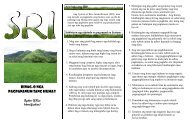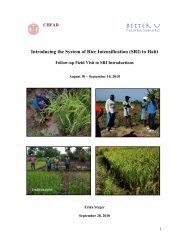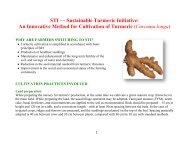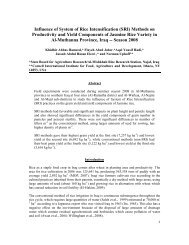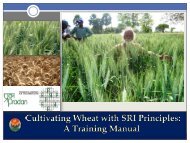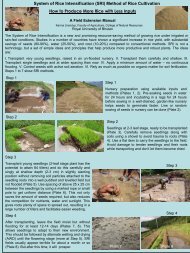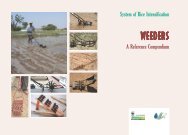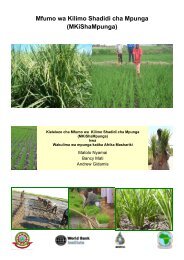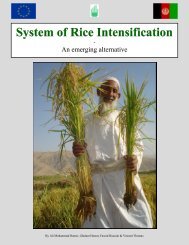EFFECT OF THE SYSTEM OF RICE INTENSIFICATION (SRI) ON ...
EFFECT OF THE SYSTEM OF RICE INTENSIFICATION (SRI) ON ...
EFFECT OF THE SYSTEM OF RICE INTENSIFICATION (SRI) ON ...
Create successful ePaper yourself
Turn your PDF publications into a flip-book with our unique Google optimized e-Paper software.
are required (app. 150-200 mm) and farmers producing lowland rainfed rice are forced to wait app.<br />
one to three months before there is enough water to puddle.<br />
3.4 Drainage periods and GHG emissions<br />
The effects of a changing water level in a rice field leading to anaerobic and aerobic conditions will<br />
influence GHGs emissions and especially methane emissions. Wassmann et al., (2000) conducted<br />
studies on CH4 emissions from five locations in Asia and discovered that soils amended with<br />
organic manure had higher emissions of GHGs compared to soils fertilized with mineral fertilizers.<br />
Intermittent flooding and mid season drainage resulted in lower emissions than with conditions of<br />
continuous flooding (Wassmann et al., 2000). Emission rates ranged from less than 100 kg CH4<br />
ha -1 to more than 400 kg CH4 ha -1 for intermittent irrigation and continuous flooding respectively<br />
(Wassmann et al., 2000). Emissions were different within the different periods of the rice crop with<br />
highest emissions during the reproductive stage and the highest temperatures (Wassmann et al.,<br />
2000) which is also true for the other GHGs.<br />
Drainage periods will lower CH4 but will however affect the emission rates of N2O. Yue et al.<br />
(2005) compared continuous flooding with intermittent flooding and their role on CH4 and N2O<br />
emissions in Southern China and found that intermittent flooding showed a 17% lower GWP<br />
compared to continuous flooding while there was no significant differences between yields.<br />
Methane emissions decreased but N2O increased with intermittent flooding but the trade-off was the<br />
most optimum as compared to continuous flooding (Yue et al., 2005). Zou et al. (2005) found that<br />
in Chinese rice fields with continuous flooding N2O emission rates was 0.03 mg m -2 d -1 as<br />
compared to rice cropping with a mid season drainage of 14.1 mg m -2 d -1 . Both treatments received<br />
2.25 t ha -1 of wheat straw. Mid season drainage periods are often used in China and Japan but not to<br />
a large extent in warmer rice growing climates (Greenland, 1997). The effect of drainage in the<br />
Cambodian climate, which is very different from the Chinese and Japanese climatic situation, might<br />
result in different emission rates due to temperature and a faster decomposition of OM.<br />
Water management involving mitigation interests or because of water shortages will have large<br />
influences on emission rates of CH4, N2O and CO2 with many trade-offs involved (Frolking et al.,<br />
2004). A farming system trying to involve mitigation of all three GHGs and involve and deal with<br />
the trade-offs would be an optimal one. But which system can cope with such challenges and still<br />
sustain the farmer and his family?<br />
21



